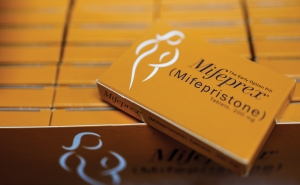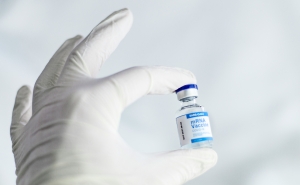
A new mouse model of infection with the COVID-19-causing SARS-CoV-2 virus during pregnancy tracks closely the disease course doctors have observed in SARS-CoV-2-infected pregnant patients, and suggests that treatment with the antiviral Paxlovid provides protection for both mother and child. The new model is described in a study led by researchers at the Johns Hopkins Bloomberg School of Public Health.
The researchers found that pregnant mice infected with SARS-CoV-2 later in gestation tended to have worse COVID-19-like disease, as seen in pregnant patients with SARS-CoV-2 infections. Treating the mice with the active ingredients in Paxlovid—an oral antiviral drug approved by the Food and Drug Administration for use against SARS-CoV-2 infection, but not widely used in pregnant patients with COVID-19—reduced their viral loads and disease signs in mothers, and prevented growth and developmental deficits in their offspring.
The study appears online in the Journal of Clinical Investigation.
“Our findings are consistent with the overall public health message that Paxlovid is safe and effective, and that if you’re pregnant it can protect you and your baby,” says study co-senior author Sabra Klein, PhD, professor in the Department of Molecular Microbiology and Immunology at the Bloomberg School.
The COVID-19 pandemic is a reminder that pregnant people are an at-risk population for more severe viral diseases—so much so that they are often among priority groups that receive immediate access to new antiviral treatments when they are authorized or approved by the FDA. During the pandemic, doctors observed that SARS-CoV-2 infection during pregnancy—especially late pregnancy—tends to cause more severe COVID-19, with a threefold greater risk of intensive care admission than the general population, as well as increased risks of preterm birth and neurodevelopmental disorders in affected infants.
Research shows that late pregnancy normally features a suppression of some maternal immune pathways, presumably to help protect the unborn child from maternal immune attack. But just how this leads to worsened viral illness in pregnant mothers and developmental deficits in children has been unclear.
To better understand these mechanisms, Klein and colleagues developed a model of SARS-CoV-2 infection in pregnancy using a standard outbred strain of laboratory mice—which means that like humans, the offspring are not identical to the mother. They exposed three sets of the animals, at three different stages of pregnancy, to a version of SARS-CoV-2 adapted to grow well in mice. The infection stages corresponded roughly to the first, second, and third trimesters of human pregnancy.
The researchers found that the pregnant mice infected in the equivalent of the third trimester had significantly worse disease symptoms, on average, compared to the other pregnant or non-pregnant mice. These symptoms included weight loss, higher levels of virus in the lungs, and evidence of lung damage, and were associated with reduced antiviral immunity.
The offspring of the third trimester-infected mothers also fared worse than the others, with slower brain development and less overall growth. Although the researchers found no sign of direct viral infection in the placentas of the mouse offspring, there was evidence of placental cell loss. The researchers are still investigating how a respiratory virus causes this placental damage, but they suspect that it may work via a disruption of normal levels of the hormone progesterone, which has important roles in establishing the placenta and maintaining pregnancy.
Finally, the researchers tested the ability of Paxlovid to protect pregnant mice from illness following SARS-CoV-2 infection. Paxlovid is a mix of an anti-SARS-CoV-2 drug called nirmatrelvir and an anti-HIV drug called ritonavir—the latter “boosts” the activity of nirmatrelvir by inhibiting an enzyme that would otherwise quickly break it down.
“Mouse-equivalent doses of these two drugs, administered four hours after infection, greatly reduced disease symptoms in mice infected late in pregnancy, and prevented adverse growth and developmental effects on their offspring,” says Patrick Creisher, one of the study’s co-first authors.
He and Jamie Perry, ScM, were graduate students working in the Klein Lab at the time of the study. Creisher is currently a PhD student at the Bloomberg School. Perry is a program specialist at the National Institute of Allergy and Infectious Diseases.
Although Paxlovid is FDA-approved for use in pregnancy-based observational studies, pregnant patients were excluded from clinical trials of the treatment, as they have been for most clinical trials since the 1970s, due to concerns about enhanced risk and liability. While most companies study drug toxicity in pregnant animals, they do not typically test drug efficacy in pregnant animals. This exclusion, says Klein, probably helps explain the lower use of the treatment in pregnancy.
“When pregnancy is an exclusion factor in clinical trials, pregnant people inherently question the safety of the drug for them and their babies,” she says. “All too often when drugs, including antivirals, are approved for use in pregnant patients, the prescription and uptake is low out of an abundance of caution and fear.”
Klein adds that she hopes the results in the new mouse model will encourage greater use of Paxlovid to protect against COVID-19 in pregnancy—and will discourage pharma companies from always treating pregnancy as an exclusion condition, especially in cases like this, where the drugs are safe.
The other co-senior authors of the study were Andrew Pekosz, PhD, a professor in the Bloomberg School’s Department of Molecular Microbiology and Immunology; and Irina Burd, MD, PhD, Sylvan Frieman, MD Professor and chair of the Department of Obstetrics, Gynecology and Reproductive Sciences at the University of Maryland School of Medicine.
“Adverse outcomes in SARS-CoV-2 infected pregnant mice are gestational age-dependent and resolve with antiviral treatment” was co-authored by Patrick Creisher, Jamie Perry, Weizhi Zhong, Jun Lei, Kathleen Mulka, Hurley Ryan, Ruifeng Zhou, Elgin Akin, Anguo Liu, Wayne Mitzner, Irina Burd, Andrew Pekosz, and Sabra Klein.
Support for the research was provided by the National Institutes of Health (R01HD097608, T32AI007417-26, N7593021C00045).
# # #
Media contacts: Barbara Benham at bbenham1@jhu.edu and Kathy Marmon at kmarmon@jhu.edu.





